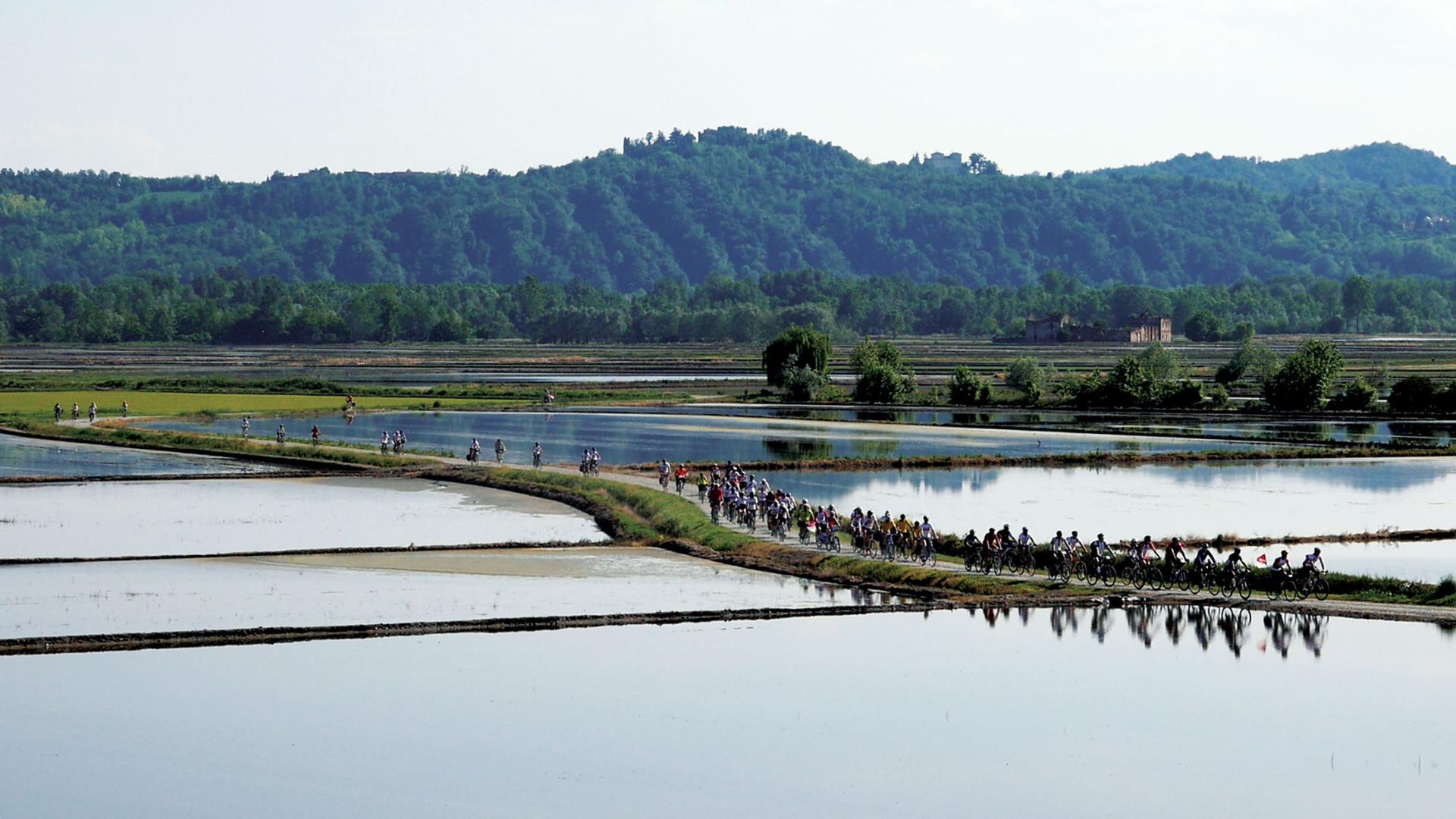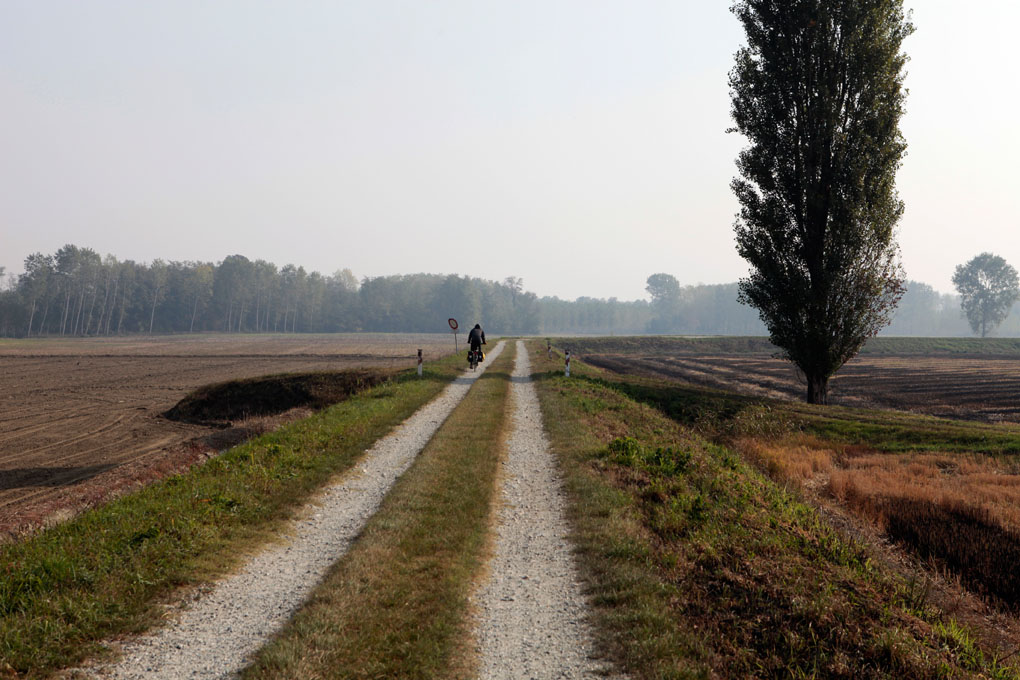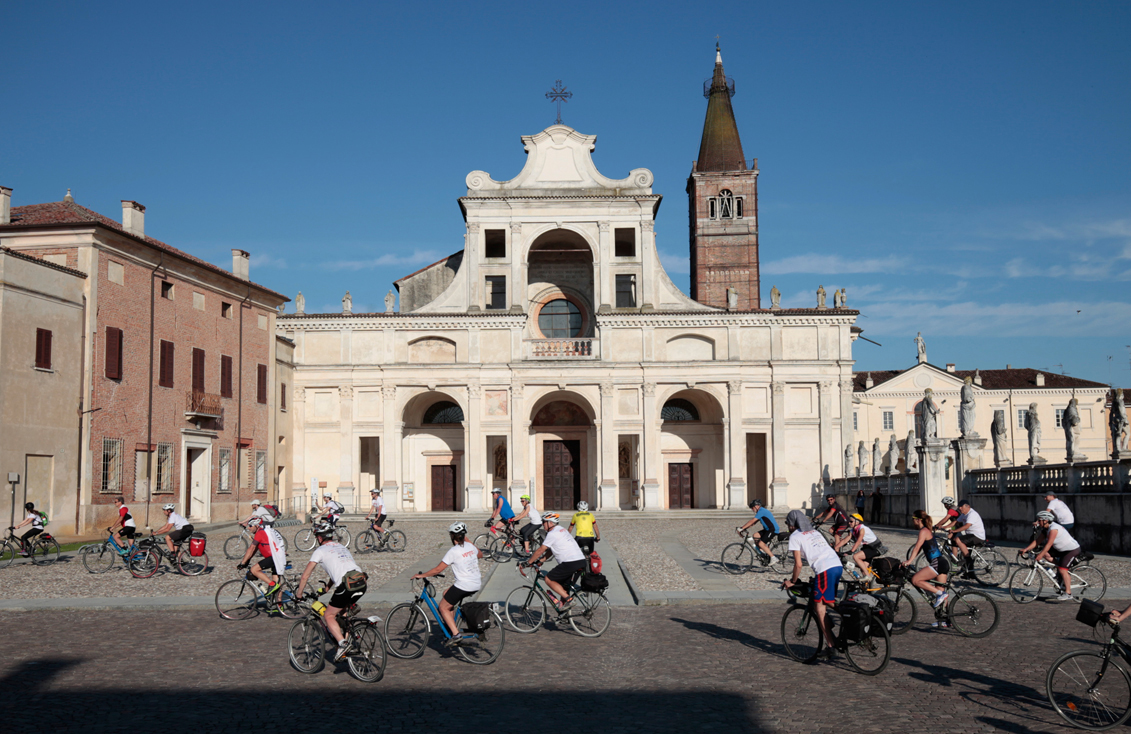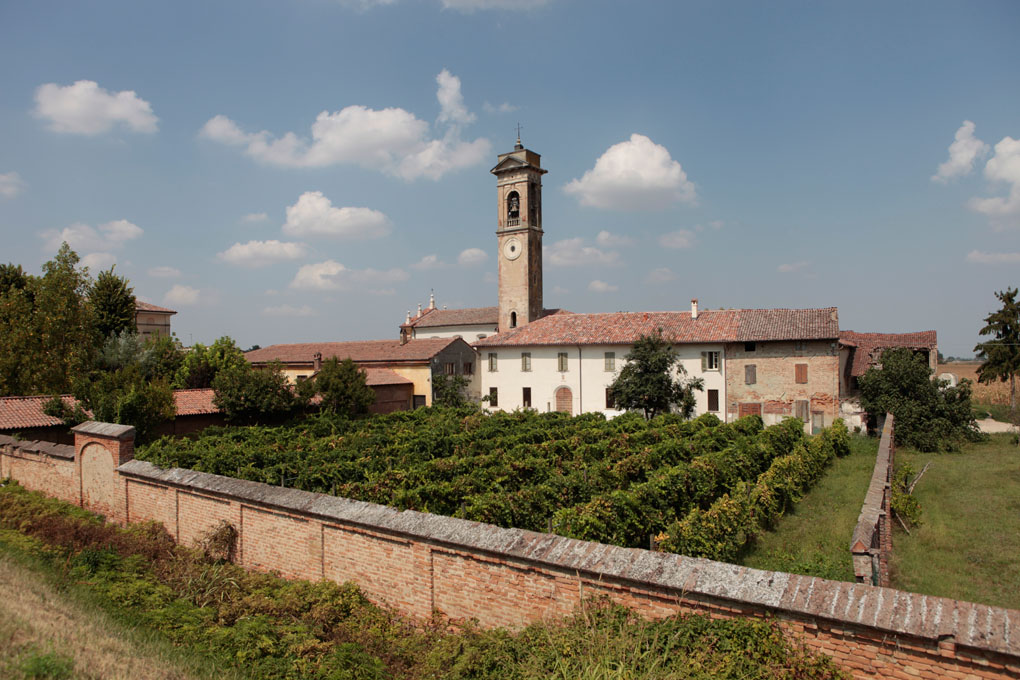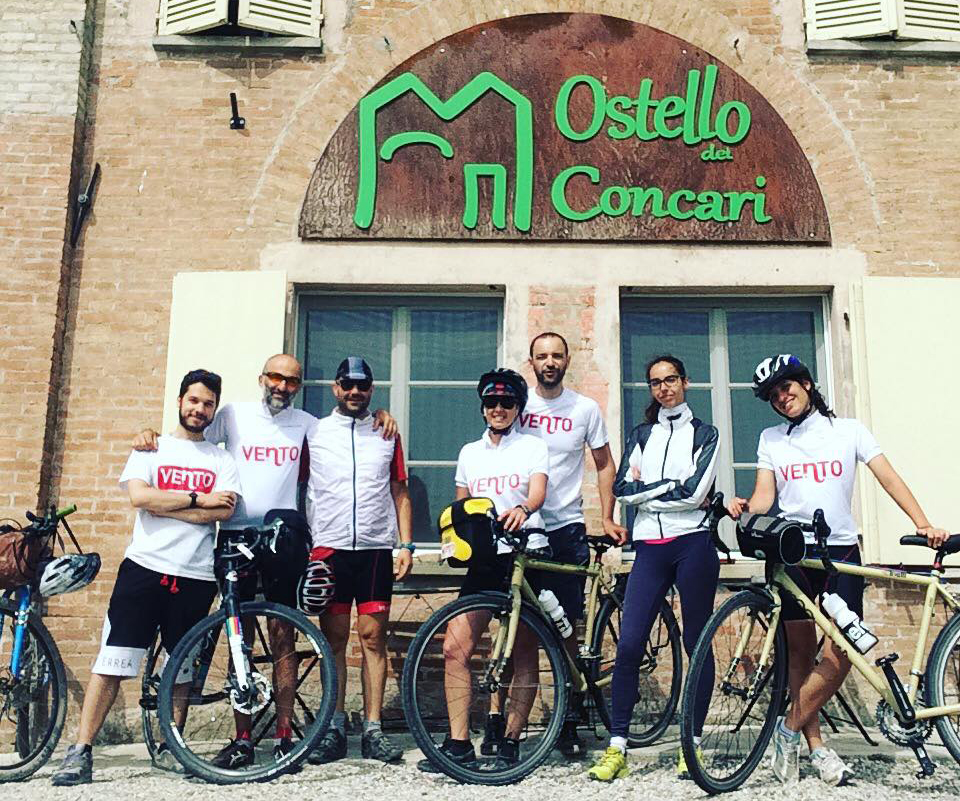VENTO cycleway, from VENice to Turin
Basic information
Project Title
Full project title
Category
Project Description
VENTO is a territorial project threading its way through the cycling-pedestrian infrastructure that will run along the banks of the river Po from VENice to Turin [TOrino]. Project VENTO was conceived at Politecnico di Milano, Department of Architecture and Urban Studies in 2010 by a research team working on sustainable territorial planning to propose a concrete and viable development option in response to the fragile situations of the marginal areas around Italy’s largest river valley.
Project Region
EU Programme or fund
Description of the project
Summary
VENTO is a cycling backbone route that is 700km long and will connect VENezia and TOrino (Venice and Turin in english) running next to the Po River. For European readers a cycling path is not news. Germany, Austria, France, The Netherlands, Great Britain and many other countries have had a cycling path network and have known the results that are generated for years. In Italy and other countries in the Mediterranean area there is almost nothing. The little cycling we have is mostly urban. Between 2008 and 2010 our research group at the Politecnico di Milano studied the great cycling routes of central Europe to understand the reasons behind this public success. With a background as territorial planners, our focus was on the positive impacts that these cycling tourism flows generated in the territories. When planning the VENTO cycling route, we were convinced that a more territorial outlook rather than cycling or sports-oriented or recreational was decisive in the design of the project. This great cycling route, whose length had not been even thought of in Italy before - 700km - became the proposal for a new model of development and not (only) the study of an alternative way of moving and travelling. A development model that includes advantages for the territories that are crossed (employment, economy, territorial protection, depopulation control, ...), and advantages for those who travel on slow routes (learning, landscape appreciation, culture, health, environmental defence, ...). In this sense we can say that the project of a cycling route must first of all be seen as a territorial project, and then as the realization of a cycling infrastructure with all of its technical features.
After many years of research and solicitation to the Government, the first official design phase approved by the Ministry of Transport ends in December 2019. Since then, more than 75 millions of euros have been allocated to complete the construction of VENTO.
Key objectives for sustainability
Cycling tourism (and bikes) have a very low environmental impact. In his extraordinary work "Energy and Equity" Ivan Illich (I. Illich, Harper & Row, 1973), around fifty years ago, noted that the bicycle was the only means of transportation that improves the efficiency of human movement and lessons environmental impact: "a cyclist can travel three or four times faster than the pedestrian, but consuming 1/5 of the energy. In order to travel 1km of flat road, the cyclist will burn 0.15 calories." If we add to this that travelling by bicycle has the lowest emissions (0.0001 kgCO2/km compared to 0.133 by car or 0.027 by train), we can say that cycling, in all its forms, is good for the climate and the environment in general: cycling could save the planet. But there’s more. Recently the World Health Organization (WHO, I. Skinner, D. Wu, C. Schweizer, F. Racioppi, R. Tsutsumi (eds.), Jobs in green and healthy transport. Unlocking new opportunities, Copenhagen, 2014) has shown that if at least one city in each country in the European Union reached the same levels of cycling as Copenhagen, there would be 9,400 fewer deaths in Europe and 76,000 more jobs. Not only do bikes consume 1/1,000 of what cars consume, but to build 1 km of cycle path, you need less than 1/10 of the cement used to construct 1 km of motorway (WHO, I. Skinner, D. Wu, C. Schweizer, F. Racioppi, R. Tsutsumi (eds.), Jobs in green and healthy transport. Unlocking new opportunities, Copenhagen, 2014)!
Key objectives for aesthetics and quality
Along its 700km, VENTO touches 150 municipalities, 4 regions, 13 provinces, 2 river agencies, 47 protected areas, a dozen UNESCO sites, several museums... VENTO’s track encourages the traveller to discover the value of the variety of lesser known Italian landscapes, local foods, folk stories. We are convinced that in this fine and almost forgotten weave lies the authenticity that is still capable of narrating the territories according to a non-obvious and very sophisticated spontaneity. VENTO connects well-known cities such as Venice, Turin, Piacenza, Cremona, Ferrara. What is 'in between' these cities is not regarded less relevant and VENTO aims at discovering this fragile 'in-between territory', by using the bicycle as an activator of new forms of tourism with low environmental impact. In this sense, the big cities are seen as great tourist attractors, able to make visible also those unknown places that are beautiful but do not have the same recognizability.
Furthermore, according to Christin, slow travel has precisely the power to re-localize the body and awaken the attention to the world, “which means finding the spirit of adventure again even in places that are at first glance insignificant” (R. Christin, Turismo di massa e usura del mondo, Eleuthera, 2019; p. 124). The vernacular side of the territory is a precious material for a project such as VENTO and therefore must be safeguarded even when project solutions are being decided on. It invites the traveller to go to the local villages, to use the local inns or trattorias, which will in turn experience a financial benefit because of them. Even guaranteeing the survival of inns by helping them to remain true to themselves and faithful to their traditions is part of a cycling tourism project with a cultural claim. If the cycling tourism project wants to take care of the local sphere, it must distance itself from certain touristic-commercial formats that have nothing to do with slow travel.
Key objectives for inclusion
The type of cycling tourism proposed by VENTO is based on four key characteristics related to the inclusivity nature of the project. The first two aspects concern a inclusivity of places, which can be defined as a "territorial / regional inclusivity". The last two, on the other hand, concern the inclusiveness of the people that can be involved in the project, therefore a "social inclusivity".
The first feature is the power to revive citizens and landscapes of the marginal zones, not just cities. In this sense the project demonstrated regional inclusivity, passing through both cities and rural and less known places.
Such characteristic is connected to the second aspect of inclusivity of the project, namely the idea of valuing the concept of transit: being between places, in contrast to the almost exclusive idea of travel as only being about the destination.
The third feature concerns social inclusivity, or rather being accessible to all. Cycling tourism is not, and should not be thought of as a sporting experience for someone who is physically prepared, but rather something cultural and enjoyable for everyone.
Finally, the other feature of the project concerns the distribution of benefits generated across a wide territory and, thus, across many different people, as opposed to the concentration of benefits in the hands of a few.
Results in relation to category
The category applied concerns the regeneration of urban and rural places. Such regeneration can be intended as economic, considering the impacts on the territory, but also as social and cultural. VENTO passes through the rural places in the Po Valley, along the mayor Italian river, and through those small towns and villages little known and in some way regarded as marginal. Which projects are created for them? The metropolitan model does not suit them. They need a model that is not subordinate, but which is a dignified alternative. The landscape once again becomes the key to finding an answer. The Italian landscape is a powerful resource that can generate opportunity if it is respected and maintained for the citizenship that it incorporates. A tourist cycle path can be the means to reviving these landscapes, enlivening the internal zones with a stream of people who can discover their secrets, beauty and how they are people-friendly. People who pass though, not cross. They stop and stay in these forgotten places, paying the interest and respect that is due. And this can spark economies, employment and well-being. VENTO crosses more than two hundred of these beautiful places, still rich in heritage and attractions, with a determined intent to reinvigorate and rediscover them. In the same way, considering the rural places, pedalling through the countryside is like watching a play, it means entering intimately into the places, the characters and their stories. Our frenetic speed doesn’t allow this because its objective is to not waste time between the departure and arrival points. Speed brings about a cultural rift that divides and breaks up the middle lands of Italy. Pedalling next to a castle or a field, along a riverbank, in a forest or along the streets of a small town can serve as a real lesson for our cultural development. Thanks to this cultural exchange, it is likely that we will become citizens who are willing to take care of the landascape.
How Citizens benefit
VENTO introduced the concept of cycling backbone route, a cycling path that becomes the main axis for a possible collection of local connections and that then connects with other axis. The great European cycling tourism is not a product of chance, but the fruit of a long and meticulous project both territorially and infra-structurally with which vision and scale of action have changed and where the pleasure of travelling for hundreds of kilometres has substituted the urgency of movement. This is what attracts thousands of visitors for more and more days. Germany alone created, in just thirty years, a long distance pedestrian and cycle pathway, that is continuous, easy, accessible to all, over 45.000 kilometres long and where every year a cycling tourism flow of 175 million holiday days are spent on bikes, totalling a turnover of just under 9 billion euro (Pileri et. al. VENTO, 2015). The German cycling tourism network gives full time employment to over 200.000 people (Blondiau, Van Zeebroeck, Economic Benefits of Increased Cycling, 2014), ten times as many as statistics show for Italy. And it’s precisely the objective of generating employment that has fascinated VENTO, making it one of the pillar of its design proposal. European cycling routes manage to combine high employment benefits (in Europe 5 employed people per km in the best cases) in view of low public investments (2-300.000 euro/km, a hundred times less than the cost of a kilometre of highway construction) and with a higher guarantee of distribution of social and economic benefits. This all proved to be a strong motivation for VENTO to propose its infrastructural and territorial vision firmly. Within cycling tourism, as in walkways, there are various types of employment, decent and appropriate to young people: restauranteurs, hotel managers, local producers, farmers, cultural guides, personal service providers, carriers, mechanics, healthcare providers, architects, urban planners, engineers, etc.
Innovative character
The scale of project VENTO is the first innovative character. Especially in the Italian context, the idea of a great cycling network that covers the territory of one or more regions (which should be straight and long-distance, around 100-150km) first experimented through the VENTO project. Given that the long distance routes exceed local ones, and that their use is mainly for tourism and hiking, they are defined as cycling tourism backbones.
The capacity of creating a cooperative vision thanks to a tourism project represents another innovative character of the project. Along its 700km, VENTO touches 150 municipalities, 4 regions, 13 provinces, 2 river agencies, various water reclamation consortiums, 1 million inhabitants, 3000 commercial activities and more than 10,000 farms. Many realities that have not been able to converge in a project that is common, as they lack the impulse towards cooperation and a vision in which they can recognize themselves.
Another innovative aspect is that VENTO is not simple an infrastructure, but it is also a cultural project for the territory crossed and for the citizens who pedaling on the cycle path. Passing slowly and continuously between different places allows them to become narrative and representative places in movement. They talk to us, they get in touch with us, they let themselves be touched and admired.
Finally, the design approach can be regarded innovative. The project has been developed in a multi-scale and multi-thematic key, by keeping many aspects together in a single design vision: that of infrastructure and cultural heritage, that of inclusion and that of territorial regeneration, etc. This approach is new not only in the Italian context, but also in comparison with other important European slow tourism infrastructures. Indeed they seem to give more importance to good technical planning, but less to the relationship with the territory crossed.


